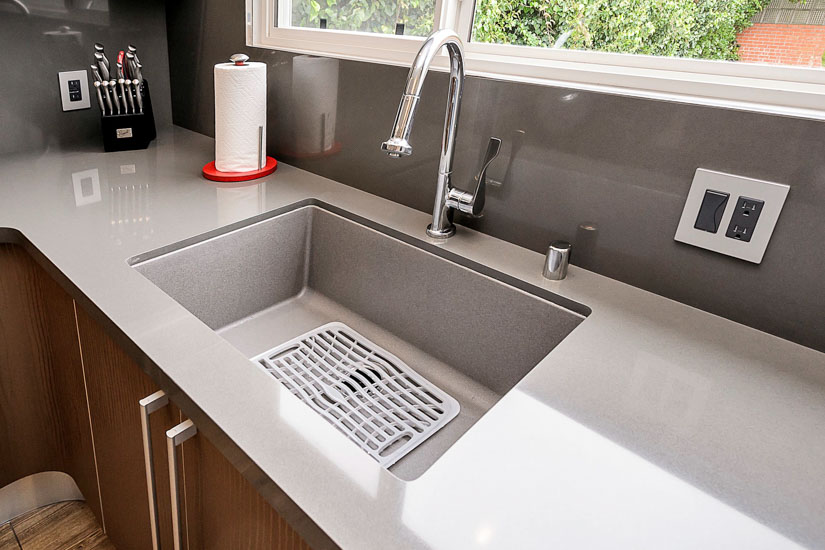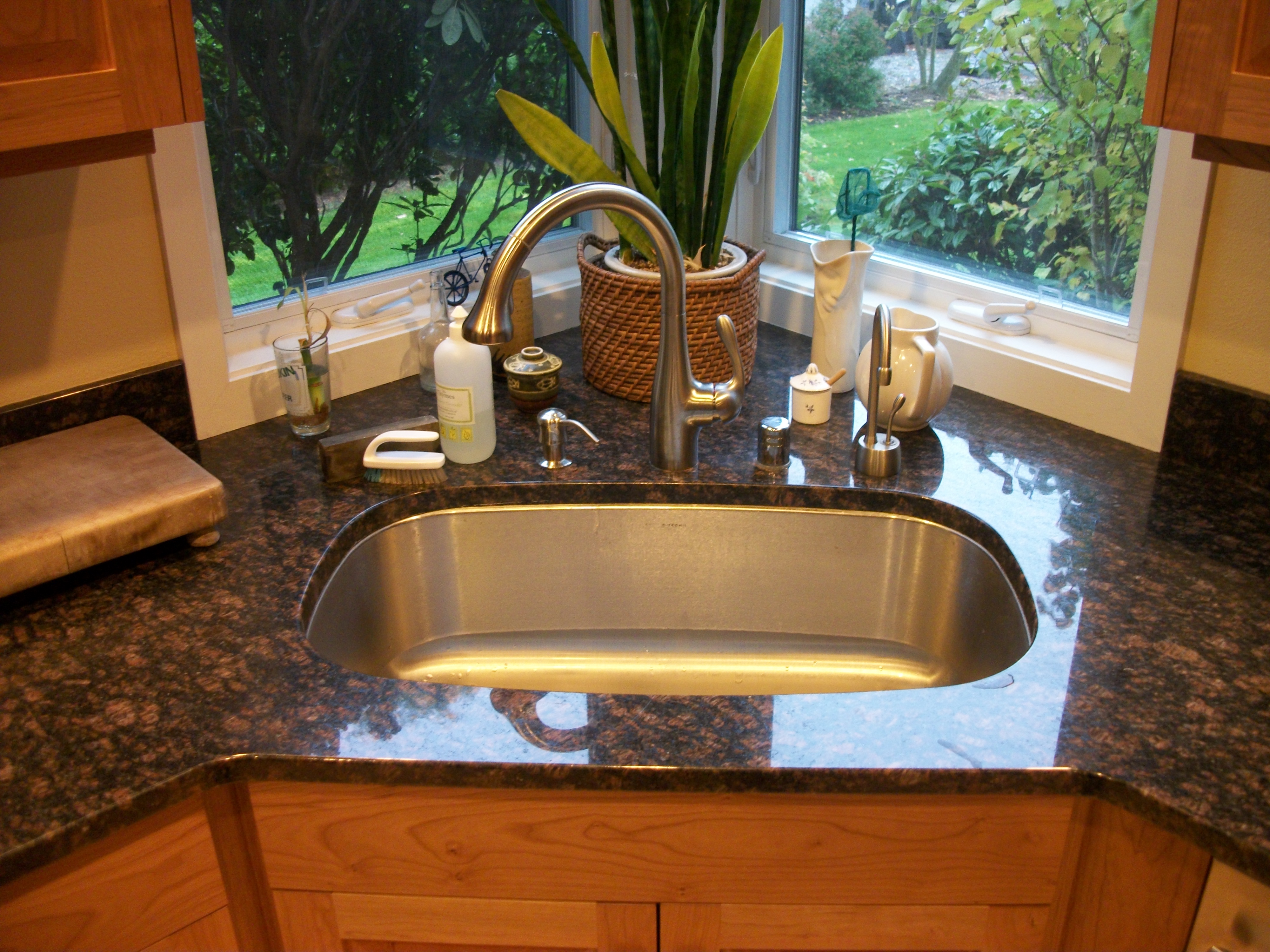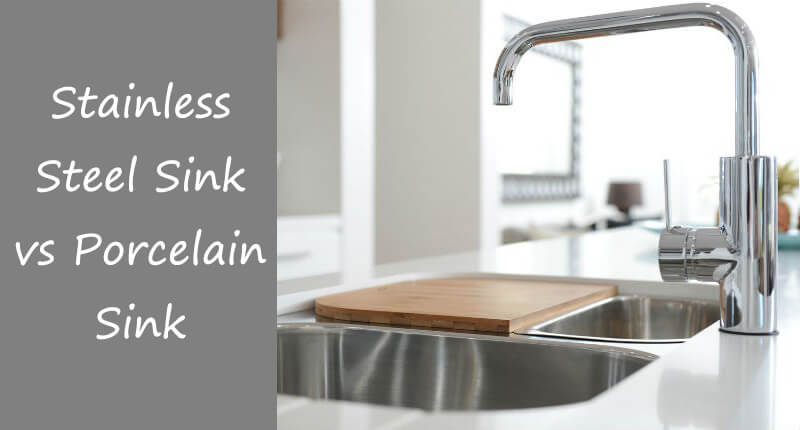When it comes to choosing a kitchen sink, the first thing you need to consider is the type of sink you want. There are several types of kitchen sinks available in the market, each with its own unique features and benefits. One popular type is the traditional topmount sink, also known as a drop-in sink. This type of sink is installed by dropping it into a pre-cut hole in the countertop. It has a rim that sits on top of the counter, making it easy to install and replace. Another type is the undermount sink, which is installed beneath the countertop for a seamless look. This type of sink is a great option for those who want a modern and sleek kitchen design. It also makes cleaning the countertop and sink much easier. Other types of kitchen sinks include farmhouse sinks, also known as apron front sinks, and bar sinks, which are smaller in size and used for bar areas or as a secondary sink in the kitchen.1. Types of Kitchen Sinks
Kitchen sinks are made from a variety of materials, each with its own pros and cons. The most common materials used in kitchen sinks include stainless steel, porcelain, granite, and composite. Stainless steel sinks are the most popular choice due to their durability, affordability, and easy maintenance. They can withstand high temperatures, are resistant to stains and scratches, and are available in a variety of finishes to match any kitchen design. Porcelain sinks have a classic and elegant look, but they are more prone to chipping and scratching. They are also not as durable as stainless steel sinks and require more maintenance to keep them looking new. Granite sinks are made from a combination of natural stone and resin, giving them a unique and luxurious appearance. They are highly durable and resistant to stains and scratches, but they can be quite expensive. Composite sinks are made from a mix of materials, such as quartz, granite, and acrylic. They are highly resistant to stains, scratches, and heat, making them a popular choice for busy kitchens.2. Materials Used in Kitchen Sinks
Kitchen sinks come in a variety of sizes to fit different kitchen layouts and needs. The most common sizes are single bowl, double bowl, and triple bowl sinks. A single bowl sink is a great option for smaller kitchens or for those who don't do a lot of dishes. It provides a large and spacious basin for all your washing needs. A double bowl sink, on the other hand, is perfect for larger kitchens and for those who prefer to have a separate area for washing and rinsing dishes. It offers versatility and convenience for multitasking in the kitchen. For those who need even more space, a triple bowl sink is the way to go. It provides three separate bowls for washing, rinsing, and drying dishes, making it ideal for big families or frequent entertainers.3. Size Differences in Kitchen Sinks
In addition to the different types and sizes, kitchen sinks also come with various mounting options. The most common ones are topmount and undermount sinks. A topmount sink, as mentioned earlier, has a rim that sits on top of the counter, making it easy to install and replace. It is also the most budget-friendly option. An undermount sink, on the other hand, is mounted beneath the countertop for a seamless look. It requires professional installation and is typically more expensive than topmount sinks. Other mounting options include flushmount, which sits flush with the countertop, and vessel sinks, which are mounted on top of the counter and require a separate faucet.4. Mounting Options for Kitchen Sinks
Single and double bowl sinks are the most common choices for kitchen sinks, and each has its own advantages and disadvantages. A single bowl sink offers one large basin for all your washing needs. It is perfect for small kitchens or for those who don't do a lot of dishes. However, it can be difficult to multitask with only one basin. A double bowl sink, on the other hand, provides two separate basins for washing and rinsing dishes. It offers versatility and convenience for multitasking in the kitchen. However, it can take up more counter space and may not be suitable for smaller kitchens.5. Differences Between Single and Double Bowl Sinks
Undermount and drop-in sinks are two popular options for kitchen sinks, and they both have their pros and cons. An undermount sink is mounted beneath the countertop for a seamless look. It makes cleaning the countertop and sink much easier, but it requires professional installation and may be more expensive. A drop-in sink, also known as a topmount sink, is dropped into a pre-cut hole in the countertop. It is easy to install and replace, but it can be more difficult to clean as food particles can get stuck in the rim.6. Undermount vs. Drop-In Kitchen Sinks
Farmhouse and apron front sinks are often used interchangeably, but they are not the same. A farmhouse sink has a large, exposed front that extends past the edge of the countertop. It provides a classic and rustic look to the kitchen but may require custom cabinetry to accommodate its size. On the other hand, an apron front sink has a front panel that is flush with the edge of the countertop. It is a more modern and sleek option and can be installed in standard cabinetry.7. Farmhouse vs. Apron Front Kitchen Sinks
Topmount and undermount sinks both have their advantages and disadvantages, and it ultimately comes down to personal preference. A topmount sink is easier to install and replace, and it is also more budget-friendly. However, it may not provide a seamless look and may be more difficult to clean. An undermount sink offers a seamless look and is easier to clean, but it may be more expensive and require professional installation.8. Topmount vs. Undermount Kitchen Sinks
Stainless steel and porcelain are two popular materials used in kitchen sinks, and they each have their own unique features. Stainless steel sinks are durable, easy to maintain, and affordable. They are also resistant to stains and scratches, making them a practical choice for busy kitchens. Porcelain sinks have a classic and elegant look, but they are less durable and require more maintenance. They are also more prone to chipping and scratching.9. Stainless Steel vs. Porcelain Kitchen Sinks
The cost of a kitchen sink can vary depending on the type, size, material, and brand. Stainless steel sinks are generally the most affordable, starting at around $100, while more high-end materials like granite or composite can cost upwards of $500. If you're on a budget, consider a topmount or single bowl sink, as they are typically more budget-friendly. But if you're willing to splurge, a high-quality undermount or double bowl sink can add value and functionality to your kitchen. Ultimately, the cost of a kitchen sink should be weighed against its features and benefits to determine the best investment for your needs and budget.10. Cost Differences Between Kitchen Sinks
The Importance of Choosing the Right Kitchen Sink for Your Home

Optimize Your Kitchen Design with the Perfect Sink
 When it comes to designing your dream kitchen, every detail matters. From the color of the cabinets to the type of flooring, each element contributes to the overall aesthetic and functionality of the space. However, one aspect that often gets overlooked is the kitchen sink. Many homeowners may not realize the impact that choosing the right sink can have on their daily kitchen experience.
Kitchen sink
is an essential fixture in any home. It is where we wash our hands, clean dishes, and prepare food. But not all sinks are created equal. There are various types of sinks available in the market, each with its unique features and benefits. Understanding the differences between them can help you make an informed decision and choose the one that best suits your needs and
house design
.
When it comes to designing your dream kitchen, every detail matters. From the color of the cabinets to the type of flooring, each element contributes to the overall aesthetic and functionality of the space. However, one aspect that often gets overlooked is the kitchen sink. Many homeowners may not realize the impact that choosing the right sink can have on their daily kitchen experience.
Kitchen sink
is an essential fixture in any home. It is where we wash our hands, clean dishes, and prepare food. But not all sinks are created equal. There are various types of sinks available in the market, each with its unique features and benefits. Understanding the differences between them can help you make an informed decision and choose the one that best suits your needs and
house design
.
Top-Mount vs. Undermount Sinks
 The two most common types of kitchen sinks are top-mount and undermount. As the name suggests, a top-mount sink is installed on top of the counter, while an undermount sink is mounted underneath the counter. Top-mount sinks are more affordable and easier to install, making them a popular choice for those on a budget. They also come in a variety of materials, sizes, and styles, making them suitable for any
kitchen design
.
On the other hand, undermount sinks offer a sleek and modern look. They are installed under the counter, creating a seamless and clean appearance. This type of sink is ideal for minimalist kitchen designs and can make a small kitchen feel more spacious. However, they may require professional installation and are typically more expensive than top-mount sinks.
The two most common types of kitchen sinks are top-mount and undermount. As the name suggests, a top-mount sink is installed on top of the counter, while an undermount sink is mounted underneath the counter. Top-mount sinks are more affordable and easier to install, making them a popular choice for those on a budget. They also come in a variety of materials, sizes, and styles, making them suitable for any
kitchen design
.
On the other hand, undermount sinks offer a sleek and modern look. They are installed under the counter, creating a seamless and clean appearance. This type of sink is ideal for minimalist kitchen designs and can make a small kitchen feel more spacious. However, they may require professional installation and are typically more expensive than top-mount sinks.
Single vs. Double Bowl
The Material Matters
 When it comes to choosing a material for your kitchen sink, there are plenty of options to choose from. Stainless steel is the most popular choice due to its durability, affordability, and easy maintenance. However, if you want a more unique and stylish look, you can opt for materials such as granite, fireclay, or copper. Each material has its pros and cons, so it's essential to consider your budget and lifestyle before making a decision.
Choosing the right kitchen sink
can make a significant impact on your daily kitchen routine and the overall look of your home. By considering factors such as sink type, size, and material, you can find the perfect sink that not only complements your
house design
but also meets your functional needs. So the next time you're remodeling your kitchen, don't forget to give your sink the attention it deserves.
When it comes to choosing a material for your kitchen sink, there are plenty of options to choose from. Stainless steel is the most popular choice due to its durability, affordability, and easy maintenance. However, if you want a more unique and stylish look, you can opt for materials such as granite, fireclay, or copper. Each material has its pros and cons, so it's essential to consider your budget and lifestyle before making a decision.
Choosing the right kitchen sink
can make a significant impact on your daily kitchen routine and the overall look of your home. By considering factors such as sink type, size, and material, you can find the perfect sink that not only complements your
house design
but also meets your functional needs. So the next time you're remodeling your kitchen, don't forget to give your sink the attention it deserves.










































































































